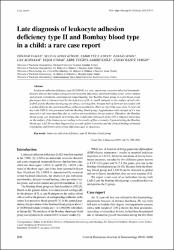| dc.contributor.author | Yaman, Yöntem | |
| dc.contributor.author | Köker, Sultan Aydın | |
| dc.contributor.author | Ayhan, Fahri Yüce | |
| dc.contributor.author | Genel, Ferah | |
| dc.contributor.author | Acıpayam, Can | |
| dc.contributor.author | Oymak, Yeşim | |
| dc.contributor.author | Sarıbeyoǧlu, Ebru Tuǧrul | |
| dc.contributor.author | Vergin, Canan Raziye | |
| dc.date.accessioned | 2019-12-26T11:54:57Z | |
| dc.date.available | 2019-12-26T11:54:57Z | |
| dc.date.issued | 2019 | en_US |
| dc.identifier.citation | Yaman, Y., Köker, S. A., Ayhan, F. Y., Genel, F., Acıpayam, C., Oymak, Y. ... Vergin, C. R. Late diagnosis of leukocyte adhesion deficiency type II and Bombay blood type in a child: A rare case report. Central European Journal of Immunology, 44(2), 206-209. https://dx.doi.org/10.5114/ceji.2019.87073 | en_US |
| dc.identifier.issn | 1426-3912 | |
| dc.identifier.issn | 1644-4124 | |
| dc.identifier.uri | http://doi.org/10.5114/ceji.2019.87073 | |
| dc.identifier.uri | https://hdl.handle.net/20.500.12511/4733 | |
| dc.description.abstract | Leukocyte adhesion deficiency type II (LAD II) is a rare, autosomal, recessive inherited immunodeficiency disease that induces frequent and recurrent infections, persistent leukocytosis, severe mental and growth retardation, and impaired wound healing. The Bombay blood group is a rare blood group phenotype that is characterised by the deficiency of H, A, and B antigens on the surface of red cells. LAD II and the Bombay blood group are always seen together, because both of them are associated with a global defect in the common pathway of fucose metabolism. Here we report the case of an 11-year-old boy with LAD II, who presented with the Bombay blood group. Agglutination with strength of 4+ was detected in all cross-matching due to erythrocyte transfusions for our patient. Therefore, the Bombay blood group was incidentally determined due to deficient expression of the CD15 adhesion molecules on the surface of the leukocytes according to the results of flow cytometry. Upon detecting the Bombay blood type, LAD II was then diagnosed as a result of flow cytometry and the clinical findings of mental retardation and history of recurrent infections such as abscesses. | en_US |
| dc.language.iso | eng | en_US |
| dc.publisher | Termedia Publishing House Ltd. | en_US |
| dc.rights | info:eu-repo/semantics/openAccess | en_US |
| dc.subject | Leukocyte Adhesion Deficiency Type II | en_US |
| dc.subject | Bombay Blood Group | en_US |
| dc.title | Late diagnosis of leukocyte adhesion deficiency type II and Bombay blood type in a child: A rare case report | en_US |
| dc.type | article | en_US |
| dc.relation.ispartof | Central European Journal of Immunology | en_US |
| dc.department | İstanbul Medipol Üniversitesi, Tıp Fakültesi, Dahili Tıp Bilimleri Bölümü, Çocuk Sağlığı ve Hastalıkları Ana Bilim Dalı | en_US |
| dc.identifier.volume | 44 | en_US |
| dc.identifier.issue | 2 | en_US |
| dc.identifier.startpage | 206 | en_US |
| dc.identifier.endpage | 209 | en_US |
| dc.relation.publicationcategory | Makale - Uluslararası Hakemli Dergi - Kurum Öğretim Elemanı | en_US |
| dc.identifier.doi | 10.5114/ceji.2019.87073 | en_US |
| dc.identifier.wosquality | Q4 | en_US |
| dc.identifier.scopusquality | Q3 | en_US |


















